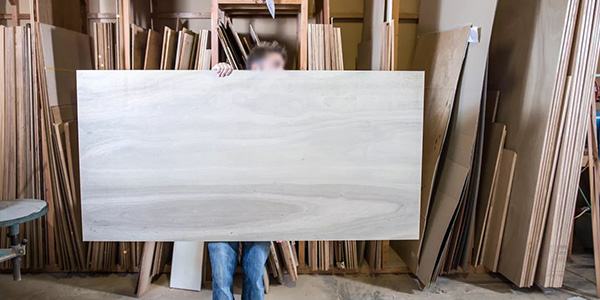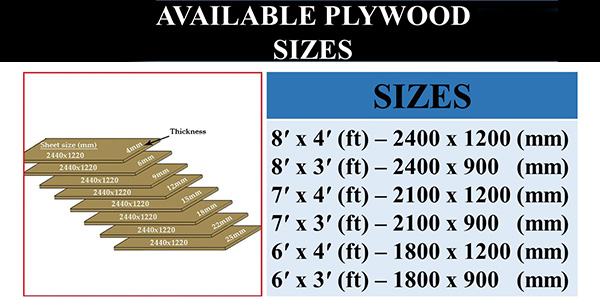Plywood Sheet Size: What You Need To Know
Nov 13, 2024
Plywood is perhaps among the most widely used building materials. It is applied in construction, assembly work, furniture, cabinets, and even decorative projects. That is why it is important to know the dimensions of plywood so as to select the very right kind for each project, which in turn helps reduce waste and thus assure a good fit and structural integrity.
Standard plywood sizes are not uniform around the world. America, India, the United Kingdom, and the Philippines all have their own traditionally favored sizes, which quite often influences their availability-a range for compatibility in the local markets.

Plywood is available in several different standard sizes and special thicknesses, depending on its applications in construction, furniture, and other fields. While some sizes are standard across industries, size is also determined by regional and purpose-specific factors.
Common Industry Sizes: The most widely used sizes include the standard 4 ft x 8 ft (1.22 m x 2.44 m), due to being apt for various construction jobs because of compatibility with common framing systems. Another very common size is 5 ft x 5 ft (1.52 m x 1.52 m). This is especially prevalent in Europe, being widely used for specific applications to furnishing and cabinetry.
Standard Thickness Options: Plywood is sold in various deviated thicknesses, commonly expressed in inches or millimeters. Common plywood standard thickness mm include:

Plywood dimensions vary by region, as different countries have their own standards and preferences. Understanding these regional dimensions is critical, especially for projects that involve sourcing materials internationally or adhering to local building codes.

According to "Indian Standard, IS:10701:2012" (Structural Plywood - Specification) and "IS:303:1989" (General Plywood Specification) , the common sizes are:
· 2.4 x 1.2 m (8 x 4 ft)
· 2.4 x 0.9 m (8 x 3 ft)
· 2.1 x 1.2 m (7 x 4 ft)
· 2.1 x 0.900 m (7 x 3 ft)
· 1.8 x 1.2 m (6 x 4 ft)
· 1.8 x 0.9 m (6 x 3 ft)
Common thickness: 3mm, 4mm, 6mm, 9mm, 12mm, 15mm, 18mm, 25mm
According to the british standards BS EN 315, common sizes of plywood are as follows:
· 2.44 x 1.22 m ( 8 x 4 ft )
· 2.74 x 122 m ( 9 x 4 ft )
· 3.05 x 1.22 m ( 10 x 4 ft )
· 2.40 x 1.22 m ( 7.8 x 4 ft )
· 2.50 x 1.22 m ( 8.2 x 4 ft )
Common thickness: 3mm, 6mm, 9mm, 12mm, 15mm, 18mm, 21mm, 24mm, 25mm
According to the standards of the Philippine Board of Standards (BPS) , the common sizes of plywood are as follows:
· 8x4 ft (2440mm x 1220mm)
· 7x4 ft (2135mm x 1220mm)
· 6x4 ft (1830mm x 1220mm)
· 6x3 ft (1830mm x 915mm)
Common thickness: 3mm, 4mm, 6mm, 9mm, 12mm, 15mm, 18mm, 25mm
The dimensional tolerance of plywood indicates the permissible ranges of deviations during the manufacture of plywood. Tolerance arises in the course of manufacturing since the wood being used is a natural material that can undergo changes in response to environmental vitiants like humidity and temperatureore. An outline of some more commonly spoken about aspects of the plywood dimensional tolerance includes:
The National Standards vary beyond borders and applicable jurisdictions. For example:
Tolerances exist to capture the deviations that occur during the manufacturing process; however short, the product must remain effective and usable in the actual clearance. When it comes to buying plywood, understanding the tolerances involved can aid you in planning and executing your projects better.
Plywood size is directly proportional to price: Size of plywood positively correlates with price. For instance, a standard 4 by 8 ft sheet of plywood may cost $15-$30, whereas an oversized sheet, either 4 by 7 ft or even smaller sized 6 by 4 ft, may generally range from $20 to $40. Thickness of wood also influences pricing,18 mm-thick sheets are way costlier than their 12 mm-thick cousins and are typically pegged from ten to twenty percent extra. The demand, quality of materials, cost of production, as well as other factors also influence price, although size remains variously cited as one of the more prominent determining factors.
In plywood manufacture, high-quality wood is selected for the core material, followed by sawing into thin wood slices or veneers. Nursing by rotary-cutting or slicing produces veneer of varying thicknesses. Following, these veneers dry off to reduce moisture content, and adhesives bond these veneers together layer by layer. The grain direction of each layer of veneer is alternated with subsequent layers: usually perpendicular to the adjacent layers of veneer during lamination to enhance strength and stability. Afterwards, glued plywood is cured and pressed directly or with the help of hot or cold methods. Ultimately, these plywood panels are trimmed to standard size and gone under various surface treatments like sanding or painting to enhance their look and durability. The entire process requires precise control of temperature, humidity and pressure so as to guarantee the quality and service performance of the plywood.
There are many types of core materials for plywood. Here are some common types of plywood core materials:
Here are some approximate weights for a standard 4x8 foot sheet:
Wood Species: Different species of wood have different densities. For example, birch plywood is generally denser than pine plywood.
Moisture Content: Plywood can absorb moisture, which increases its weight.
Construction: The way the plywood is constructed (the number of plies, the type of glue, etc.) can affect its weight.
Recognizing the attributes of plywood that relate to size, thickness, core material, and geographical variables will serve as a guideline for selecting the right plywood for any specific project. In determining the best plywood for your particular project, it would be prudent to consider its intended usage; whether for structural or decorative purposes, budget constraints, environmental factors, and desired aesthetics. The better informed you are regarding nominal versus actual thickness, plywood tolerances, and core material types, the more likely that your plywood will be durable, cost-effective, and aesthetically pleasing. Proper planning and selection will ultimately increase the success of your project and save time and resources.
Why is 3/4-inch plywood actually less than 3/4-inch thick?
How to choose the right plywood for your project?
How to avoid the problem of inappropriate plywood size?